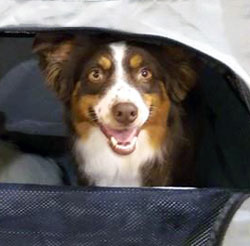Looking around at your first competition, it’s hard to believe anyone there now was ever there for the first time. Some have been there so long they’ve forgotten what it’s like to feel new. You will want to know simple things that veterans take for granted. There typically aren’t any indicators posted as to where to go, who to see, what steps to take. This article is meant to help you in that area. Your experience may be different because each club is unique, each location is different, that makes it challenging to describe. But I’ll give it a go..
Step ONE
Preparation begins at home.
First, you need to enter. Each organization’s entry forms are different. If you are able to muddle through like I did and get your entry sent in on time, you’ve achieved the first challenge! Not knowing the lingo sent me to the rule books every entry form I filled out. It still does!
Here’s a USDAA entry form help file
After you’ve sent in your form and money, you will receive a confirmation of entry via email and likely some other information as well. My favorite of these is the ‘Running Order’. There’s something rewarding about seeing my dog’s name on the list of people to run that day.
Print and take with you all the paperwork you have accumulated for entering this trial. Usually, that includes: the entry info, a map to the trial location (if needed), the registration and or height card for your dog, the running order and or schedule of runs. You may need all of those items for information throughout the day.
Bring a chair, a crate, drinks, food (if needed for both you and your dog), snacks, dog treats, dog toys (quiet ones!), poop bags, and anything the weather may require for you and your dog. If you have a cart to carry all those items, it can be very helpful since you may have a distance to walk to get to the arena and crating area.
Arrive early!
That’s the best thing you can do for yourself, especially since you don’t know what’s going on yet.
Step TWO
Get settled with your dog.
 Different events offer different options for crating. From what I’ve seen so far, mostly you just look for a spot and stake your claim with your chair, crate, rug, whatever you have. Depending on the crating space, you will either have to use as little space as possible, or be able to spread out in comfort. Be mindful of the situation.
Different events offer different options for crating. From what I’ve seen so far, mostly you just look for a spot and stake your claim with your chair, crate, rug, whatever you have. Depending on the crating space, you will either have to use as little space as possible, or be able to spread out in comfort. Be mindful of the situation.
Things you may want to think about as you choose your spot: How noisy are the other dogs around you? How will your own dog react to the noise (especially if they are completely new to this environment)? How far are you to the ring you will most likely be competing in? Where are you in relation to wind, rain, sun, etc? It’s so relative to what type of location you’ll be in that I have to be vague.
You will find it’s challenging to leave, especially at first when you aren’t familiar with how long things take. I’ve missed runs because I left for a few minutes. Personally, I find the time management aspect the most difficult to figure out.
Step THREE
Check-in, get measured
Typically there is no signage or other indication. I have wandered around looking for the mystery location from which the agility world will revolve for that day. My best clue? Look for where other people are somewhat congregated. If there’s no table there, ASK someone. If they know more than you do, they should know at least that much.
In this world, people are moving around a lot and usually on their way somewhere. If someone doesn’t answer you politely, just ask someone else.
Check-in usually involves finding a list or binder with your name and number somewhere that you check off to indicate that you are there. My own experience indicates there are no standards. All clubs, all organizations and all venues seem to be slightly different. You may have to ask about this too. I promise that once you’ve done it a few times, you will find this much easier.
You will also need to get your dog measured. Show up early, be ready ON-TIME for what is stated in the entry or trial confirmation as to when dog measuring will take place. At the time listed, usually a line will form near a measuring table. The judge will show up and measure each dog in line until they are all done. Have treats to get cooperation from your dog, and your height card ready. USDAA sends you one, AKC has a form you fill out. NADAC has one you print out. You will need your registration number. Again, each organization is slightly different.
Most of the time there are course maps at the check in table. Pick up the ones that apply to you for that day.
Step FOUR
Find your ring, your name and ready your dog.
You’ve set up your crate, checked in, gotten measured…now what?
At each ring entrance, there is placed a list of who is running and in what order. Each day has a pattern of running either “Tall to small”, or “Small to Tall”. The lingo refers to how they’ve organized the running order for the whole day. You will find your ring, find the list and put a checkmark next to your name to indicate your presence for that run. Be mindful that these runs go pretty fast. There is extra time for height changes, course changes, judges meetings. It is important to watch this list frequently because it can change without notice. This list let’s you know when it’s your turn to run.
When the judge enters the ring before each group of runs (classes), they will have a brief meeting discussing the course. It’s a good time to ask questions. A lot of times they will assume everyone knows what the rules are, but just let them know you are new and if you have a specific question, don’t hesitate to ask. After the short meeting, you get a chance to walk the course.
If it’s a large show, there may be a lot of people walking. Try to focus on what you need to do to prepare for this run and not get distracted by the others in the ring.
Step FIVE
Get ready to rumble! Prepare your dog.
Make sure your dog has been taken out to potty. Have your toy or treats ready, if you need them. Make sure you take neither INTO the ring unless you know for sure they are allowed. Typically people kinda line up in order of their turn to make the process go smoother. Some courses mention when to enter the ring during the previous dog’s run. This makes the day go faster and smoother, but depending on the dogs, not always possible. Do what’s best for your dog.
When it’s your turn, enter the ring, ready yourself at the Start line, remove leash and/or collar (rules differ depending on organization). There is normally someone standing nearby to move your leash from where you drop it to the place at the exit where you will pick it up.
Usually the Starting line is associated with the first jump. Sometimes it’s a line between timer ‘eyes’. Be sure to set up behind the start line eye. Wait for the indicator that it’s OK for you to go. In USDAA this has been an automated “GO” or “READY”. In NADAC, it’s the judge saying “Good Luck”. In AKC it has also been a “GO”.
Have a fun run with your dog!
After your run, look for your leash on a chair, in a bucket, on the ground near the exit, but be sure to get your leash/collar back on your dog before leaving the ring. Some of the organizations have faults for not doing this, so just make sure it’s done for all of them.
Step SIX
 Collect your winnings!
Collect your winnings!
You ran fast, ran clean. The others in your class ran well too. Now you want to know how you did. Well, start looking for that mysterious unmarked table again. It will have binders, papers and boxes of ribbons. You may have seen it at check-in, or may not.
It will take some time between your run and posting of the results. It depends on how large the show is as to how long. Some trials also have a computer monitor set up to show results more immediately after they’ve been entered into the computer.
When you think enough time may have passed, find the table with the ribbons nearby. Look for the binder with your run listed within. Find your name/dogs name. This listing will show the results of your run, whether you placed or qualified or not. If you are at an AKC event, you can only place if you qualified. If you are at a USDAA event, you can place and/or Qualify. Sometimes there are stickers printed out within that same binder that you can take and place on your ribbons. Collect your own ribbons accordingly. There are placement ribbons and qualification (Q) ribbons. Your first event, first run, first ribbon, first Q, it’s all very exciting, congratulations! You did it!!
Now What’s Next?
Repeat all of the above, especially the fun part!
Tell the truth now, you are loving the sport. Welcome to the club of other agility addicts!



